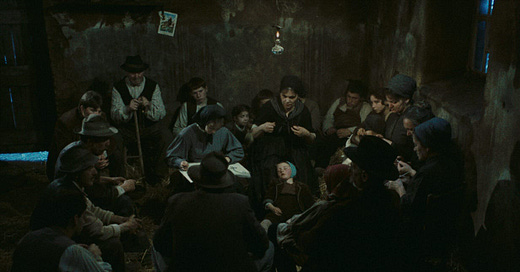55. Nostos (Louise Glück)
Le he contestado el saludo por WhatsApp a mi prima con un incauto “mándame fotos de la familia”, y me ha enviado—no exagero—¡¡90!! Para madres orgullosas, mi prima, así que me he entretenido un buen rato con los vídeos y fotos de sus dos pequeños (6 y 4 años) en todo tipo de eventos: recital de piano, show navideño, clases de tenis, cumpleaños y, mis favoritas, los trabajos en la finca. Su marido se dedica a cuestiones agrarias—ganadería en una época, creo que ahora cultiva arándanos—y tienen una finca con variedad de animales: gallinas, conejos, ovejas, un par de ponis (por lo que veo en las fotos). Es un paraíso para los niños y toda una educación. Pienso con frecuencia en lo bien que les hace a los niños estar cerca del tierra y ayudar con trabajos en el campo. Ryan Anderson tiene un artículo que me encanta—Mama Shot the Deer!—en el que cuenta la bendición que ha sido para sus hijos crecer en el homestead que, casi inesperadamente, comenzó con su mujer. Este párrafo es magnífico:
Our children know quite a bit about the miracle of life, actually. They’ve witnessed goat labor, and it looks exactly as you might expect. They were in the pasture with my wife and me as one mama goat gave birth to three kids, one of which came out with the sac fully intact, spraying amniotic fluid and breaking only upon hitting the ground. They know the entity growing in a womb is a baby: a baby goat when in a goat womb, a baby human when in a human womb. They both kissed their mother’s belly once it started showing that their baby brother was inside. They also know that not all newborns make it. One of our lambs was born with the sheep equivalent of cleft palate, making him unable to nurse at his mother’s teat. We hadn’t built our barn yet, so we brought him into the house to bottle-feed. Shortly before dinnertime, he died on the dining room floor. We didn’t talk too much about it, but also didn’t downplay it. We hoped the experience would convey something of the goodness and the fragility of life. The children knew that we had done what we could to help that lamb, but also that there are limits to what any of us can do. Many people fear and deny death (and, in a different way, birth), but for now our kids seem unfazed by both.
En las fotos de mi prima veo una alegría que me entusiasma (y que ha merecido el perdón por la inundación de fotos en el chat). Pongo aquí una del pequeño de 4 años que me ha hecho recordar con viveza mi propia infancia. Captura perfectamente esa emoción, ese nerviosismo, de sostener algo vivo, pequeño, cálido, movedizo y frágil en tus manos. Casi puedo escuchar los gritillos.
A propósito de los niños y el campo, hace unos meses vi la que diría actualmente que es mi película favorita: El árbol de los zuecos (1978) de Ermanno Olmi. Una maravilla.
NOSTOS
Louise Glück
There was an apple tree in the yard —
this would have been
forty years ago — behind,
only meadows. Drifts
off crocus in the damp grass.
I stood at that window:
late April. Spring
flowers in the neighbor's yard.
How many times, really, did the tree
flower on my birthday,
the exact day, not
before, not after? Substitution
of the immutable
for the shifting, the evolving.
Substitution of the image
for relentless earth. What
do I know of this place,
the role of the tree for decades
taken by a bonsai, voices
rising from tennis courts —
Fields. Smell of the tall grass, new cut.
As one expects of a lyric poet.
We look at the world once, in childhood.
The rest is memory.



